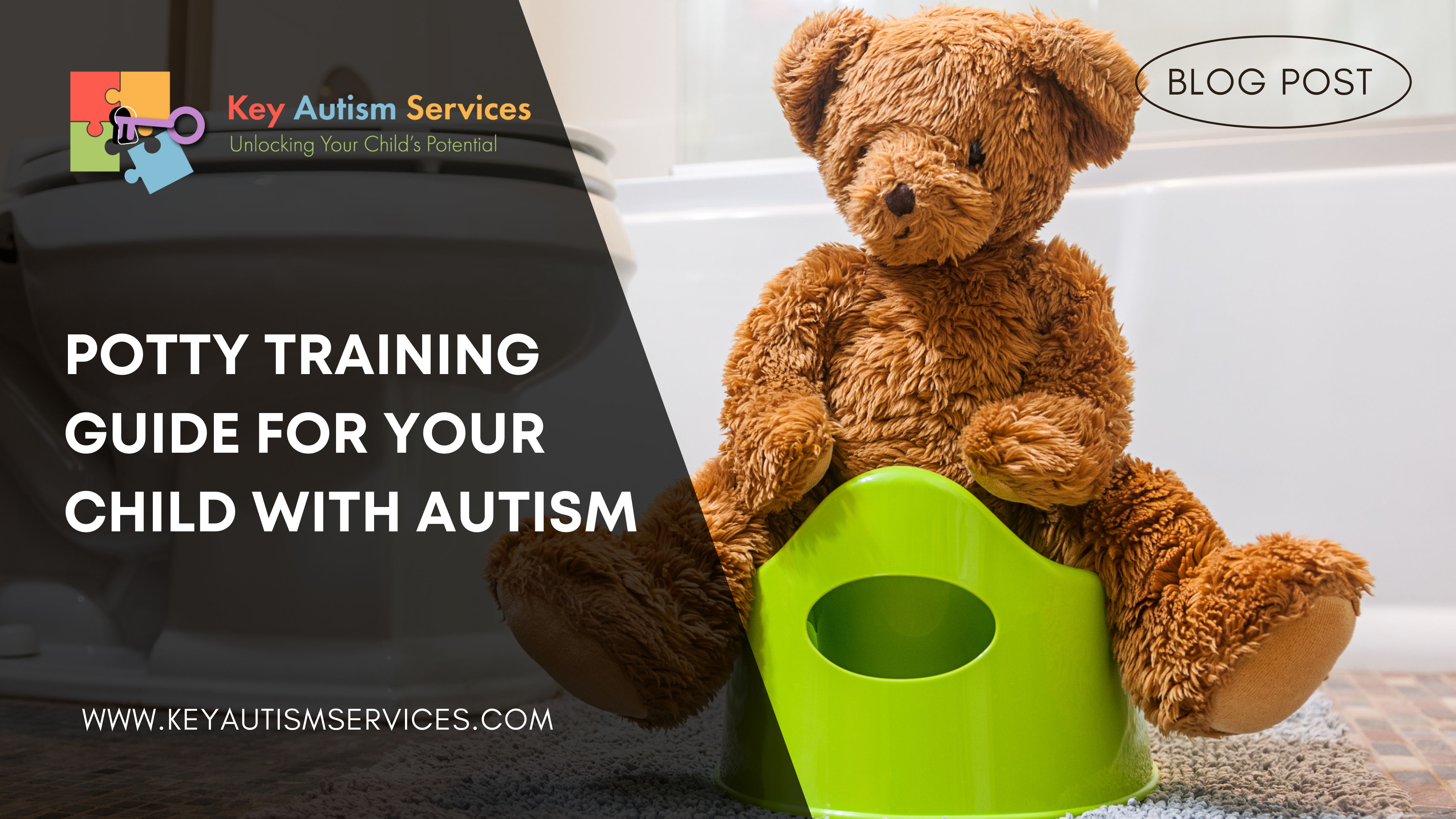Written by: Rachel Miller, MA, LLP, BCBA, LBA
Potty training any child can be a daunting task, and while it can be a little different for children with autism, it can also be a very similar process, but just take a little longer. The first step for potty training is determining when to start.
Indications a child is ready to start would be:
- Child awareness of going – ex. may hide or grunt during BM
- Long periods of dryness
- Urinating large amounts at one time
- Somewhat regular bowel movements
- Shows interest in using the toilet
- Able to effectively indicate the need to go with words, signs, or pictures.
- Knows the difference between wet and dry and can pull pants up and down (good preliminary skills, but not mandatory)
- Able to follow 1-2 step directions
- Willing to sit on his/her chair or toilet for at least 1 minute
- Demonstrates some imitation behavior
- Shows a desire to gain approval from others
You want to start by teaching the necessary behaviors needed. Each child will develop at his/her own pace, so be patient. Start working on requests for saying, “Potty” or other words. Using sign language or PECS can also help for indicating the need to go if they are not talking yet. Start working on pulling pants up and down independently. Practice sitting on the chair or toilet and building up to 5 minutes using a visual timer (my personal favorite is the countdown timer app).
Teach your child the difference between wet and dry. Practice following simple 1-2 step directions and make sure to praise, praise, praise for any of these or related behaviors is very important. You want the child to think that potty training is fun and exciting.
The most important thing to remember is never to scold for going in a diaper or pants and avoid showing any signs of frustration. Children will sense if you are frustrated and that will make them feel like there is something wrong with them for not being able to do some of these things. It can lead to the child not wanting to try at all or hiding in the corner when going in their pants. It could make accidents worse, and they may become afraid to let you know when they have gone.
Tips for getting started:
Once your child has many of the readiness skills discussed above, you can move into a more intensive type of potty training. At some point to fully train a child they will have to come out of pull-ups. I recommend using thicker cloth training underwear with a protective cover to limit the effects of accidents. This is important for them to feel when they are going and feel the wetness. A pull-up is also going to make them more likely to go in their pants as it creates a setting that previously allowed them to go in their pants (diapers). Once switching to underwear, start on a weekend, so you have two full days to devote to training. This will help with frustration due to accidents. Clear your calendar and plan to stay at home to focus on potty training for both days.
Be sure to give lots of fluids during those days and start by having them sit on the potty for 5 minutes every 10 minutes. Even if you are working with a boy, you want them to always start by sitting, so that it is much easier to train bowel movements on the toilet as well. Before taking them each time, be sure to prompt them to say potty or use pecs/sign language to say potty. This helps to teach them how to tell you they must go. Be sure to have lots of reinforcers available such as small edibles or preferred toys that they can gain access to for sitting on the potty and urinating or having a bowel movement. As soon as they go on the potty or 5 minutes pass they can get up and resume play near the bathroom. Be sure to give lots of enthusiastic praise and immediate reinforcement of a small edible or toy every time they go even if only a little bit. Saving special edibles or toys only for this reason will help to make it more reinforcing to them.
Try to keep your eyes on them as much as possible to see if they show any signs of going so you can immediately put them on the toilet. You may even use a tracking chart to check for patterns of when they tend to go. One trick for getting them to urinate while on the toilet is to put their bare feet or hands in some warm water.
Using a Potty-Training Doll
I also recommend using potty scotty or potty patty dolls that can be found online. These can help to model what you are trying to teach them to do. Engaging in pretend play with the doll and giving reinforcement to the doll when going on the potty can be a powerful teaching method. Other steps for this method include:
- Putting the doll in big kid underwear.
- Assisting your child in feeding the doll a bottle.
- Allowing your child to see and feel that the doll is dry and pretend to give the doll a small treat while praising “Good job staying dry!”
- Have the doll accidentally wet his/her pants and show your child the doll is wet, then say “Uh Oh! It looks like (name of doll) needs to practice going potty!”
- Go to different parts of the house, then run to the toilet and place the doll on the potty. Do this 2-3 times.
- Change the doll’s pants to dry and give the doll another pretend reward with praise for staying dry.
- About 5 minutes later say “What’s that (doll name)? You have to go potty?” Then take the doll and have it go to the toilet.
- Go crazy with excitement, give the doll a pretend reward, praise, high five, and do a potty dance all around the house with your child singing “(Doll name) went pee on the potty, (doll name) went pee on the potty!”
- Talk about what a big kid (doll name) is!
- Make potty training fun for your kid and it will become fun for you too!
Wet/ Dry Pant Checks
In addition to reinforcement of going on the potty, you will want to have your child feel their underwear and talk about whether they are wet or dry. If they are dry, you can give a small reinforcer with lots of praise. “Great job staying dry!”
If they are wet, this is a good time to practice going potty. Do not scold or this could delay your progress. Accidents are part of the learning process. Instead, you can say, “Uh Oh! It looks like (child’s name) needs to practice going potty!” Then Go to different parts of the house and run to the toilet, pull down their pants and have them sit on the potty. You will have to gauge how many times they can do this without triggering tantrums or frustration, but you may do this up to ten times. Some children will only tolerate doing this 1-2 times. You may also say in a non-scolding neutral tone of voice, “Poop and pee go in the potty.” If they had a bowel movement in their underwear, you could show them it goes in the toilet by putting whatever you can into the toilet from their underwear with them watching while you say, “Poop goes in the potty.”
Long-term Training
Once your child successfully initiates or goes in the potty at home, you can begin to reduce how often you take them to 15 minutes, 30 minutes, or even an hour between sitting.
Always have them go before leaving the house and when arriving somewhere immediately show them where they can go in the community at restaurants, libraries, etc. so they know they have a place to go. If you do not care for public toilets, then I recommend getting a portable potty you can keep in your car.
Most importantly, be sure you do not use disposable training pants except for sleeping. Your child will go in his/her pants if wearing disposable training pants because it is hard to feel that an accident has occurred. Putting rubber covers over underwear would be okay to assist with any accidents, but disposable diapers strengthen the response of going in pants instead of the toilet, thus undoing all your progress.
You do not want to ruin any progress made by putting on pull-ups in the community and allowing them to go that way when out and about, but then expect them to stay dry at home. It will be too confusing for them. However, there will be times that they have to go in the community, and bringing a portable toilet is not possible, such as when traveling by plane, so getting them used to doing this from the beginning even if only a few times is a good idea.
It is important to remember the process may take time and vary per child. The process can be quick for some and take weeks for others. If you see regression due to inconsistency, just start over at the beginning on another weekend. With a little bit of patience and consistency, most children with autism CAN be potty trained. You can do this!
Best wishes and good luck.






